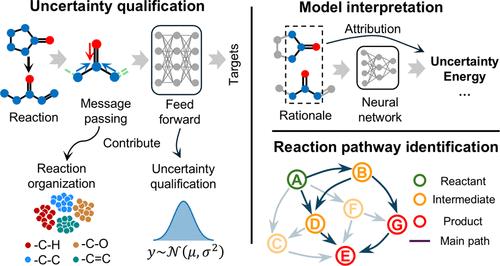当前位置:
X-MOL 学术
›
J. Chem. Inf. Model.
›
论文详情
Our official English website, www.x-mol.net, welcomes your
feedback! (Note: you will need to create a separate account there.)
Uncertainty Qualification for Deep Learning-Based Elementary Reaction Property Prediction
Journal of Chemical Information and Modeling ( IF 5.6 ) Pub Date : 2024-10-23 , DOI: 10.1021/acs.jcim.4c01358 Yan Liu, Yiming Mo, Youwei Cheng
Journal of Chemical Information and Modeling ( IF 5.6 ) Pub Date : 2024-10-23 , DOI: 10.1021/acs.jcim.4c01358 Yan Liu, Yiming Mo, Youwei Cheng

|
The prediction of the thermodynamic and kinetic properties of elementary reactions has shown rapid improvement due to the implementation of deep learning (DL) methods. While various studies have reported the success in predicting reaction properties, the quantification of prediction uncertainty has seldom been investigated, thus compromising the confidence in using these predicted properties in practical applications. Here, we integrated graph convolutional neural networks (GCNN) with three uncertainty prediction techniques, including deep ensemble, Monte Carlo (MC)-dropout, and evidential learning, to provide insights into the uncertainty quantification and utility. The deep ensemble model outperforms others in accuracy and shows the highest reliability in estimating prediction uncertainty across all elementary reaction property data sets. We also verified that the deep ensemble model showed a satisfactory capability in recognizing epistemic and aleatoric uncertainties. Additionally, we adopted a Monte Carlo Tree Search method for extracting the explainable reaction substructures, providing a chemical explanation for DL predicted properties and corresponding uncertainties. Finally, to demonstrate the utility of uncertainty qualification in practical applications, we performed an uncertainty-guided calibration of the DL-constructed kinetic model, which achieved a 25% higher hit ratio in identifying dominant reaction pathways compared to that of the calibration without uncertainty guidance.
中文翻译:

基于深度学习的基本反应性质预测的不确定性定性
由于深度学习 (DL) 方法的实施,对基本反应的热力学和动力学性质的预测显示出快速改进。虽然各种研究都报告了预测反应性质的成功,但很少研究预测不确定性的量化,从而影响了在实际应用中使用这些预测性质的信心。在这里,我们将图卷积神经网络 (GCNN) 与三种不确定性预测技术集成在一起,包括深度集成、蒙特卡洛 (MC) 随机转换和证据学习,以提供对不确定性量化和效用的见解。深度集成模型在准确性方面优于其他模型,并且在估计所有基本反应性质数据集的预测不确定性方面显示出最高的可靠性。我们还验证了深度集成模型在识别认识和随机不确定性方面表现出令人满意的能力。此外,我们采用了蒙特卡洛树搜索方法来提取可解释的反应子结构,为 DL 预测性质和相应的不确定性提供了化学解释。最后,为了证明不确定性鉴定在实际应用中的实用性,我们对 DL 构建的动力学模型进行了不确定性引导校准,与没有不确定性引导的校准相比,该模型在识别主要反应途径方面的命中率提高了 25%。
更新日期:2024-10-24
中文翻译:

基于深度学习的基本反应性质预测的不确定性定性
由于深度学习 (DL) 方法的实施,对基本反应的热力学和动力学性质的预测显示出快速改进。虽然各种研究都报告了预测反应性质的成功,但很少研究预测不确定性的量化,从而影响了在实际应用中使用这些预测性质的信心。在这里,我们将图卷积神经网络 (GCNN) 与三种不确定性预测技术集成在一起,包括深度集成、蒙特卡洛 (MC) 随机转换和证据学习,以提供对不确定性量化和效用的见解。深度集成模型在准确性方面优于其他模型,并且在估计所有基本反应性质数据集的预测不确定性方面显示出最高的可靠性。我们还验证了深度集成模型在识别认识和随机不确定性方面表现出令人满意的能力。此外,我们采用了蒙特卡洛树搜索方法来提取可解释的反应子结构,为 DL 预测性质和相应的不确定性提供了化学解释。最后,为了证明不确定性鉴定在实际应用中的实用性,我们对 DL 构建的动力学模型进行了不确定性引导校准,与没有不确定性引导的校准相比,该模型在识别主要反应途径方面的命中率提高了 25%。


















































 京公网安备 11010802027423号
京公网安备 11010802027423号